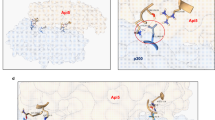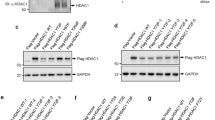Abstract
We previously reported that the activation of p21WAF1/Cip1 transcription by histone deacetylase inhibitor apicidin was mediated through Sp1 sites and pointed to the possible participation of protein kinase C (PKC). In this study, we investigated the role and identity of the specific isoforms of PKC involved and identified phosphatidylinositol 3-kinase (PI 3-kinase) as an upstream effector in HeLa cells. Using an isoform-specific pharmacological inhibitor of PKC, a PKCɛ dominant-negative mutant, and antisense oligonucleotide to inhibit PKCɛ specifically, we found that among PKC isoforms, PKCɛ was required for the p21WAF1/Cip1 expression by apicidin. In addition to PKCɛ, PI 3-kinase appeared to participate in the activation of p21WAF1/Cip1 promoter by apicidin, since inactivation of PI 3-kinase either by transient expression of dominant-negative mutant of PI 3-kinase or its specific inhibitors, LY294002 and wortmannin, attenuated the activation of p21WAF1/Cip1 promoter and p21WAF1/Cip1 protein expression by apicidin. Furthermore, membrane translocation of PKCɛ in response to apicidin was blocked by the PI 3-kinase inhibitor, indicating the role of PI 3-kinase as an upstream molecule of PKCɛ in the p21WAF1/Cip1 promoter activation by apicidin. However, the p21WAF1/Cip1 expression by apicidin appeared to be independent of the histone hyperacetylation, since apicidin-induced histone hyperacetylation of p21WAF1/Cip1 promoter region was not affected by inhibition of PI 3-kinase and PKC, suggesting that the chromatin remodeling through the histone hyperacetylation alone might not be sufficient for the expression of p21WAF1/Cip1 by apicidin. Taken together, these results suggest that the PI 3-kinase–PKCɛ signaling pathway plays a pivotal role in the expression of the p21WAF1/Cip1 by apicidin.
This is a preview of subscription content, access via your institution
Access options
Subscribe to this journal
Receive 50 print issues and online access
$259.00 per year
only $5.18 per issue
Buy this article
- Purchase on Springer Link
- Instant access to full article PDF
Prices may be subject to local taxes which are calculated during checkout







Similar content being viewed by others
Abbreviations
- HDAC:
-
histone deacetylase
- PKC:
-
protein kinase C
- Cdk:
-
cyclin-dependent kinase
- TSA:
-
trichostatin A
- NaB:
-
sodium butyrate
- SAHA:
-
suberoylanilide hydroxamic acid
- PDBu:
-
phorbol-dibutyrate
- ERK:
-
extracellular-regulated protein kinase
- PKA:
-
protein kinase A
- MAPK:
-
mitogen-activated protein kinase
References
Anderson KE, Coadwell J, Stephens LR and Hawkins PT . (1998). Curr. Biol., 8, 684–691.
Besson A and Yong VW . (2000). Mol. Cell. Biol., 20, 4580–4590.
Blume SW, Snyder RC, Ray R, Thomas S, Koller CA and Miller DM . (1991). J. Clin. Invest., 88, 1613–1620.
Bouwman P and Philipsen S . (2002). Mol. Cell. Endocrinol., 195, 27–38.
Braun H, Koop R, Ertmer A, Nacht S and Suske G . (2001). Nucleic Acids Res., 29, 4994–5000.
Cenni V, Doppler H, Sonnenburg ED, Maraldi N, Newton AC and Toker A . (2002). Biochem. J., 363, 537–545.
Chedid M, Michieli P, Lengel C, Huppi K and Givol D . (1994). Oncogene, 9, 3021–3024.
Chin YE, Kitagawa M, Su WCS, You ZH, Iwamoto Y and Fu XY . (1996). Science, 272, 719–722.
Choi HS, Lee JH, Park JG and Lee YI . (2002). Biochem. Biophys. Res. Commun., 296, 1005–1012.
Cousens LS, Gallwitz D and Alberts BM . (1979). J. Biol. Chem., 254, 1716–1723.
Datto MB, Yu Y and Wang XF . (1995). J. Biol. Chem., 270, 28623–28628.
Draetta GF . (1994). Curr. Opin. Cell Biol., 6, 842–846.
Dulic V, Kaufmann WK, Wilson SJ, Tlsty TD, Lees E, Harper JW, Elledge SJ and Reed SI . (1994). Cell, 76, 1013–1023.
El-Deiry WS, Harper JW, O'Connor PM, Velculescu VE, Canman CE, Jackman J, Pietenpol JA, Burrell M, Hill DE and Wang Y . (1994). Cancer Res., 54, 1169–1174.
El-Deiry WS, Tokino T, Velculescu VE, Levy DB, Parsons R, Trent JM, Lin D, Mercer WE, Kinzler KW and Vogelstein B . (1993). Cell, 75, 817–825.
El-Deiry WS, Tokino T, Waldman T, Oliner JD, Velculescu VE, Burrell M, Hill DE, Healy E, Rees JL, Hamilton SR, Kinzler KW and Vogelstein B . (1995). Cancer Res., 55, 2910–2919.
Espinos E and Weber MJ . (1998). Brain Res. Mol. Brain Res., 56, 118–124.
Grunstein M . (1997). Nature, 389, 349–352.
Halevy O, Novitch BG, Spicer DB, Skapek SX, Rhee J, Hannon GJ, Beach D and Lassar AB . (1995). Science, 267, 1018–1021.
Han JW, Ahn SH, Kim YK, Bae GU, Yoon JW, Hong S, Lee HY, Lee YW and Lee HW . (2001). J. Biol. Chem., 276, 42084–42090.
Han JW, Ahn SH, Park SH, Wang SY, Bae GU, Seo DW, Kwon HK, Hong S, Lee HY, Lee YW and Lee HW . (2000). Cancer Res., 60, 6068–6074.
Harper JW, Adami GR, Wei N, Keyomarsi K and Elledge SJ . (1993). Cell, 75, 805–816.
Hollstein M, Sidransky D, Vogelstein B and Harris CC . (1991). Science, 253, 49–53.
Hoshikawa Y, Kwon HJ, Yoshida M, Horinouchi S and Beppu T . (1994). Exp. Cell Res., 214, 189–197.
Hu PP, Shen X, Huang D, Liu Y, Counter C and Wang XF . (1999). J. Biol. Chem., 274, 35381–35387.
Huang L, Sowa Y, Sakai T and Pardee AB . (2000). Oncogene, 19, 5712–5719.
Hunter T and Pines J . (1994). Cell, 79, 573–582.
Kardassis D, Papakosta P, Pardali K and Moustakas A . (1999). J. Biol. Chem., 274, 29572–29581.
Kijima M, Yoshida M, Sugita K, Horinouchi S and Beppu T . (1993). J. Biol. Chem., 268, 22429–22435.
Kim YB, Lee KH, Sugita K, Yoshida M and Horinouchi S . (1999). Oncogene, 18, 2461–2470.
King RW, Jackson PK and Kirschner MW . (1994). Cell, 79, 563–571.
Kwon HJ, Owa T, Hassig CA, Shimada J and Schreiber SL . (1998). Proc. Natl. Acad. Sci. USA, 95, 3356–3361.
Kwon SH, Ahn SH, Kim YK, Bae GU, Yoon JW, Hong S, Lee HY, Lee YW, Lee HW and Han JW . (2002). J. Biol. Chem., 277, 2073–2080.
Lee TH, Chuang LY and Hung WC . (2000). Oncogene, 19, 3766–3773.
Le Good JA, Ziegler WH, Parekh DB, Alessi DR, Cohen P and Parker PJ . (1998). Science, 281, 2042–2045.
Li YJ, Laurent-Puig P, Salmon RJ, Thomas G and Hamelin R . (1995). Oncogene, 10, 599–601.
Liu M, Iavarone A and Freedman LP . (1996). J. Biol. Chem., 271, 31723–31728.
Martinez-Balbas MA, Bauer UM, Nielsen SJ, Brehm A and Kouzarides T . (2000). EMBO J., 19, 662–671.
Mitsuuchi Y, Johnson SW, Selvakumaran M, Williams SJ, Hamilton TC and Testa JR . (2000). Cancer Res., 60, 5390–5394.
Moriya S, Kazlauskas A, Akimoto K, Hirai S, Mizuno K, Takenawa T, Fukui Y, Watanabe Y, Ozaki S and Ohno S . (1996). Proc. Natl. Acad. Sci. USA, 93, 151–155.
Nakajima H, Kim YB, Terano H, Yoshida M and Horinouchi S . (1998). Exp. Cell. Res., 241, 126–133.
Nakano K, Mizuno T, Sowa Y, Orita T, Yoshino T, Okuyama Y, Fujita T, Ohtani-Fujita N, Matsukawa Y, Tokino T, Yamagishi H, Oka T, Nomura H and Sakai T . (1997). J. Biol. Chem., 272, 22199–22206.
Noda A, Ning Y, Venable SF, Pereira-Smith OM and Smith JR . (1994). Exp. Cell Res., 211, 90–98.
Parekh D, Ziegler W, Yonezawa K, Hara K and Parker PJ . (1999). J. Biol. Chem., 274, 34758–34764.
Park JS, Lee KR, Kim JC, Lim SH, Seo JA and Lee YW . (1999). Appl. Environ. Microbiol., 65, 126–130.
Peterson D and Thiel G . (1996). Eur. J. Biochem., 239, 827–834.
Petrovics G, Bird T, Lehel C, Oravecz T and Anderson WB . (2002). Arch. Biochem. Biophys., 397, 217–223.
Polyak K, Kato J-Y, Solomon JM, Sherr CJ, Massague J and Roberts JM . (1994). Genes Dev., 8, 9–22.
Prives C and Manley JL . (2001). Cell, 107, 815–818.
Richon VM, Sandhoff TW, Rifkind RA and Marks PA . (2000). Proc. Natl. Acad. Sci. USA, 97, 10014–10019.
Rivero JA and Adunyah SE . (1998). Biochem. Biophys. Res. Commun., 248, 664–668.
Saito A, Yamashita T, Mariko Y, Nosaka Y, Tsuchiya K, Ando T, Suzuki T, Tsuruo T and Nakanishi O . (1999). Proc. Natl. Acad. Sci. USA, 96, 4592–4597.
Sherr CJ . (1994). Cell, 79, 551–555.
Sherr CJ and Roberts JM . (1995). Genes Dev., 9, 1149–1163.
Sowa Y, Orita T, Minamikawa-Hiranabe S, Mizuno T, Nomura H and Sakai T . (1999). Cancer Res., 59, 4266–4370.
Sternglanz R . (1996). Trends Biochem. Sci., 21, 357–35.
Suske G . (1999). Gene, 238, 291–300.
Toker A, Meyer M, Reddy KK, Falck JR, Aneja R, Aneja S, Parra A, Burns DJ, Ballas LM and Cantley LC . (1994). J. Biol. Chem., 269, 32358–32367.
Van Lint C, Emiliani S and Verdin E . (1996). Gene Expr., 5, 245–253.
Wu C . (1997). J. Biol. Chem., 272, 28171–28174.
Wymann MP, Bulgarelli-Leva G, Zvelebil MJ, Pirola L, Vanhaesebroeck B, Waterfield MD and Panayotou G . (1996). Mol. Cell. Biol., 16, 1722–1733.
Yano H, Nakanishi S, Kimura K, Hanni N, Saitoh Y, Fukui Y, Nonomura Y and Matsuda Y . (1993). J. Biol. Chem., 268, 25846–25856.
Ziegler WH, Parekh DB, Le Good JA, Whelan RD, Kelly JJ, Frech M, Hemmings BA and Parker PJ . (1999). Curr. Biol., 9, 522–529.
Acknowledgements
This work was supported by Grant No. R01-2002-000-00213-0 from the Basic Research Program of the Korea Science and Engineering Foundation. We thank Dr Y Sowa (Kyoto Prefectural University of Medicine) for giving us the pWP101 reporter gene, Dr G Thiel (Medical Biochemistry and Molecular Biochemistry, University of the Saarland Medical Center) for delta-Sp1, Dr A Toker (Boston Biomedical Research Inst., Harvard Medical School) for PKCɛ-KW, and Dr M Wymann (Institute of Biochemistry, University of Fribourg, Switzerland) for PI3K-KR.
Author information
Authors and Affiliations
Corresponding author
Rights and permissions
About this article
Cite this article
Kim, Y., Han, JW., Woo, Y. et al. Expression of p21WAF1/Cip1 through Sp1 sites by histone deacetylase inhibitor apicidin requires PI 3-kinase–PKCε signaling pathway. Oncogene 22, 6023–6031 (2003). https://doi.org/10.1038/sj.onc.1206875
Received:
Revised:
Accepted:
Published:
Issue Date:
DOI: https://doi.org/10.1038/sj.onc.1206875
Keywords
This article is cited by
-
Apicidin-resistant HA22T hepatocellular carcinoma cells massively promote pro-survival capability via IGF-IR/PI3K/Akt signaling pathway activation
Tumor Biology (2014)
-
Regulation of adipocyte differentiation by histone deacetylase inhibitors
Archives of Pharmacal Research (2009)
-
Phosphoinositide 3-kinase is required for high glucose-induced hypertrophy and p21WAF1 expression in LLC-PK1 cells
Kidney International (2007)
-
TGF-β1 induction of p21WAF1/cip1 requires smad-independent protein kinase C signaling pathway
Archives of Pharmacal Research (2007)
-
Potentiation of the anticancer effect of valproic acid, an antiepileptic agent with histone deacetylase inhibitory activity, by the kinase inhibitor Staurosporine or its clinically relevant analogue UCN-01
British Journal of Cancer (2006)



